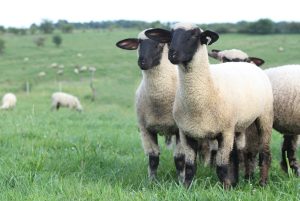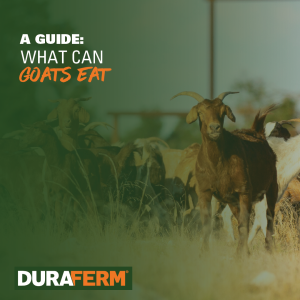
Sheep Breeding Season
For most sheep producers, their goals are to lamb out healthy, high-performing lambs – preferably two per ewe. Healthy lambs start with one pivotal time of year, the sheep breeding season. The success of this period determines next year’s lamb crop, the flock’s genetic progress, and ultimately, profitability. A well-prepared sheep breeding season begins long before rams meet the ewes or semen is shipped in. It requires thoughtful management, sound nutrition, and attention to the details that influence fertility, conception rates, and overall flock health.
As breeding season often falls in late fall or early winter, conditions can challenge both ewes and rams. Nutritional needs increase, day length changes influence reproductive cycles, and weather extremes can stress the flock. Taking a proactive approach to preparing your animals helps ensure a high conception rate, strong lambs, and efficient lambing come spring.
Advice from the Experts
At BioZyme®, the makers of DuraFerm®, we specialize in vitamin and mineral supplements to strengthen your stock by supporting reproductive success and enhancing overall health. DuraFerm is a line of nutritional supplements for sheep and goats that promotes optimal digestion and nutrition, maximizing performance at every stage of production, especially during breeding season.
That’s why our team created this resource to help you prepare for sheep breeding season and meet your needs. Let’s explore how to prepare both ewes and rams for a productive sheep breeding season.
Understanding the Sheep Breeding Season
Sheep are seasonally polyestrous, meaning day length impacts their reproductive activity. Most breeds come into estrus as days shorten, which naturally aligns breeding season with fall and early winter. This seasonal breeding tendency ensures that lambs are born in the spring, when temperatures are warmer and forages are abundant.
However, not all breeds are strictly bound by photoperiod. Some, like the Dorset, Polypay, and Rambouillet, can be bred out of season, providing producers with flexibility in their breeding programs. Other breeds can also breed out of season, using modern reproductive technologies. Regardless of breed or breeding season, maximizing conception rates and lamb survival starts with flock preparation.
Preparing Ewes for Breeding
Healthy, fertile ewes are the cornerstone of any successful lamb crop. Before sheep breeding season begins, ewes should be evaluated, conditioned, and nutritionally primed to support conception and early gestation.
1. Proper Body Condition is Important for Sheep Breeding Season
Monitor the body condition of ewes and maintain them at an appropriate body condition score (BCS) for breeding. Sheep have a BCS that ranges between 1 and 5, with 1 being extremely thin and 5 being obese. Ewes should be in good body condition, with a body condition score ranging between 2.5 and 3.5, neither too thin nor overweight. That will help them optimize fertility and reproductive performance. Adjust feeding and management practices as needed to achieve and maintain the desired body condition.
2. Reproductive Soundness
Assess the reproductive soundness of ewes, including estrus cycle monitoring and breeding history. Monitor the onset and duration of estrus (heat) cycles, detect signs of heat, and use breeding management techniques to optimize breeding timing and success rates.
While planning your breeding timing and management, don’t forget to check out our DuraFerm Sheep Gestation Calculator. Based on a 145-day gestation length, this calculator is an excellent resource for determining lambing dates from breeding dates.
Check your previous year’s lambing records. If there is an ewe that requires assistance lambing or lost her lambs due to health reasons, it might be a good time to cull her. You don’t need to invest in the time and resources of breeding sheep that potentially aren’t good producers.
3. Synchronize & Monitor Estrus
Producers managing large flocks may use estrus synchronization to tighten the lambing window and improve breeding efficiency. Hormonal protocols or controlled internal drug release (CIDR) devices can help align cycles for artificial insemination or natural breeding.
Even without synchronization, close observation of ewes during the breeding period helps identify those cycling properly and ensures rams are breeding effectively.
4. Manage Health & Environment
Conduct pre-breeding health assessments and vaccinations to ensure that ewes are in good health and free from any underlying health issues that could impact breeding success. Discuss any health concerns or conditions, such as parasitic infestations, metabolic disorders, or infectious diseases, with your veterinarian.
Provide a suitable breeding environment for ewes, including clean and comfortable housing facilities, adequate space, ventilation, and protection from extreme weather conditions. Minimize stressors and disturbances during the breeding season to promote reproductive health and well-being.
Preparing Rams for Breeding
Rams make up only a small percentage of the flock but have an outsized impact on flock productivity. One ram can service dozens of ewes, so his fertility, health, and condition directly influence your lamb crop. Preparing rams for breeding season should begin at least two months before turnout.
1. Perform a Breeding Soundness Exam (BSE)
A veterinary breeding soundness exam (BSE) is one of the best investments you can make before sheep breeding season. Between 2 and 3 weeks before you plan to turn out your rams, it is advisable to conduct BSE with your veterinarian.
The BSE evaluates two important components of your breeding rams. First, it will evaluate the structural soundness. Your rams must be sound on their feet and legs so they can physically walk to and mount the ewes. Rams must have healthy feet and hooves and should have good vision and be free of wool blindness.
The second part of the BSE is a reproductive and semen check. The veterinarian should check the scrotal health of your ram and collect a semen sample for evaluation. Scrotal circumference is also a good indicator of fertility. A younger ram should have a scrotal circumference of at least 30 cm, and rams over 18 months should have a circumference of at least 35 cm.
Additionally, the veterinarian should make sure the penis is not broken or bruised. This is also a good time to inform the veterinarian if the ram has experienced a fever or any sickness, as both can impact fertility.
2. Optimize Body Condition
Rams should enter breeding season at a body condition score of 3.0 to 3.5. Rams that are too thin may tire quickly, while overweight rams can experience reduced libido and fertility.
As rams can lose up to 10–15% of their body weight during active breeding, their nutritional plane should support stamina, fertility, and endurance. High-quality forages supplemented with a balanced mineral program like DuraFerm® Sheep Concept•Aid® help maintain strength and vigor through the season.
3. Monitor Breeding Progress
During breeding season, closely observe flock behavior to confirm mating activity. Marking harnesses or crayon markers on rams can help track which ewes are bred and when. Record-keeping allows you to estimate lambing dates and identify potential reproductive issues early.
If conception rates are lower than expected, re-evaluate nutrition, mineral intake, and ram performance. Subtle nutritional imbalances or mineral deficiencies are often the hidden causes of poor fertility.
4. Environmental & Management Considerations
Beyond nutrition and health, environmental factors can influence breeding performance. Rams are more active in moderate weather, while extreme heat or cold can lower fertility and libido. If breeding occurs during early winter, ensure adequate shelter, bedding, and wind protection to keep animals comfortable.
Nutrition: The Foundation of Sheep Breeding Success
Nutrition is the key to every successful sheep breeding season. Ewes and rams alike need the right balance of energy, protein, and minerals to perform at their reproductive optimum. Products like DuraFerm® Concept•Aid® Sheep Mineral are specifically formulated for breeding animals, providing the precise nutrients required for conception, embryo survival, and overall reproductive efficiency.
One way to ensure your flock is getting the vitamins and minerals they need is with a vitamin and mineral supplement from DuraFerm®. DuraFerm is a line of nutritional supplements for small ruminants that supports optimal digestion and nutrition for maximized performance at every stage of production. That means DuraFerm offers solutions for weight gain, general health, and sheep and goat breeding.
Three sheep formulas are available to fit any management scenario or time of year:
DuraFerm® Concept•Aid® Sheep
DuraFerm Concept•Aid Sheep is a free-choice vitamin and mineral supplement for sheep designed to support reproductive success. It contains AO-Biotics® Amaferm®, a prebiotic research-proven to enhance digestibility and high levels of vitamin E for reproductive tract repair. DuraFerm Concept•Aid Sheep supports embryo production and conception using organic trace minerals.
This loose mineral now comes in both 50- and 12-pound sizes to satisfy the needs of any flock size.
DuraFerm® Concept•Aid® Sheep Protein Tub
DuraFerm Concept•Aid Sheep Protein Tub is a protein tub with vitamins and minerals for sheep designed to support reproductive success. In addition to Amaferm, it contains the Concept•Aid sheep mineral package in a 16% natural protein tuba. It supports embryo production and conception using organic trace minerals and high levels of vitamin E.
DuraFerm® Concept•Aid® HEAT® Sheep
DuraFerm Concept•Aid HEAT Sheep is a free-choice vitamin and mineral supplement for sheep designed to support reproductive success when temperatures are above 70 degrees Fahrenheit. In addition to Amaferm, it contains HEAT technology, which combines essential oils and garlic to support animals when heat and insects are a challenge. It supports embryo production and conception using organic trace minerals and high levels of vitamin E.
You likely wouldn’t use HEAT this time of year, unless in a hot or humid climate. However, it is highly beneficial for any summertime breeding programs.
Setting the Stage for a Productive Lamb Crop
Preparing for sheep breeding season takes time, management, and the right nutritional tools. By focusing on health, body condition, and digestive efficiency, you set the foundation for strong conception rates, uniform lamb crops, and a productive lambing season.
A proactive approach pays dividends—healthier ewes, fertile rams, and vigorous lambs that grow efficiently from day one. As with most things in livestock production, success in the breeding pasture starts months before breeding begins, and it begins with good management, good nutrition, and a strong foundation for reproductive success.
Make ‘Em Stick with DuraFerm
Increase your reproductive success – get your ewes bred and make ‘em stick this breeding season with vitamin and mineral supplements from DuraFerm, powered by Amaferm
DuraFerm is available through the extensive BioZyme dealer network. Locate a dealer near you today.
Don’t forget to refer to our DuraFerm Sheep Gestation Calculator. This interactive guide will help you plan your matings.
You can also learn more about DuraFerm from our educational blog series or by signing up for our newsletter.

